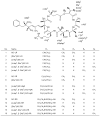Effects of the amino acid constituents of microcystin variants on cytotoxicity to primary cultured rat hepatocytes
- PMID: 24380975
- PMCID: PMC3920255
- DOI: 10.3390/toxins6010168
Effects of the amino acid constituents of microcystin variants on cytotoxicity to primary cultured rat hepatocytes
Abstract
Microcystins, which are cyclic heptapeptides produced by some cyanobacterial species from algal blooms, strongly inhibit serine/threonine protein phosphatase and are known as hepatotoxins. Microcystins have many structural variations, yet insufficient information is available on the differences in the cytotoxic potentials among the structural variants. In this study, the cytotoxicities of 16 microcystin variants at concentrations of 0.03-10 μg/mL to primary cultured rat hepatocytes were determined by measuring cellular ATP content, and subsequently determined by their 50% inhibitory concentration (IC50). Differences in the amino acid constituents were associated with differences in cytotoxic potential. [D-Asp3, Z-Dhb7] microcystin-LR exhibited the strongest cytotoxicity at IC50 of 0.053 μg/mL among the microcystin variants tested. Furthermore, [d-Asp3, Z-Dhb7] microcystin-HtyR was also highly cytotoxic. These results suggest that both D-Asp and Z-Dhb residues are important in determining the cytotoxic potential of microcystin variants.
Figures




References
-
- Jochimsen E.M., Carmichael W.W., An J., Cardo D.M., Cookson S.T., Holmes C.E., Antunes M.B.C., de Melo Filho D.A., Lyra T.M., Barreto V.S.T., et al. Liver failure and death after exposure to microcystins at a hemodialysis center in Brazil. N. Engl. J. Med. 1998;338:873–878. doi: 10.1056/NEJM199803263381304. - DOI - PubMed
-
- Codd G.A., Bell S.G., Kaya K., Ward C.J., Beattle K.A., Metcalf J.S. Cyanobacterial toxins, exposure routes and human health. Eur. J. Physiol. 1999;34:405–415.
Publication types
MeSH terms
Substances
LinkOut - more resources
Full Text Sources
Other Literature Sources
Research Materials

